Daniel Barenboim is resurrected in Salzburg

Listening to Daniel Barenboim in his dual role as pianist and conductor has been the norm for decades and a privilege available to all, because his work was incessant, overwhelming, superhuman. Now, however, enjoying this unique musician has become the exception due to the serious deterioration of his health , a downward spiral that began in April 2022 in Berlin, when he collapsed in his dressing room during the interval of a concert. Shortly before , he had performed as a soloist leading the Vienna Philharmonic at the Philharmonie and conducted—from memory, as always —Mozart's three operas from librettos by Lorenzo da Ponte at the Staatsoper. He himself announced in the autumn of that year that he was suffering from "a serious neurological illness," and last February, in another statement, he was more specific: "Today I want to inform you that I am suffering from Parkinson's disease."
A whopping 71 years ago, when he was just a child, Barenboim met Wilhelm Furtwängler in Salzburg, who had only a few months left to live, and praised his talent. The previous year, he had begun studying conducting there with Igor Markevich . Does he still remember all that? Was he shaken by the return to Salzburg? After a very long silence, the Argentine genius has returned to lead his Divan Orchestra on a brief tour of Germany, Austria, and Switzerland, with his presence hanging in the balance until the last moment. On the previous tour, to the Far East, he had to cancel his participation, and his close friend Zubin Mehta took over, another ailing fighter who refuses to give up and who will return to conduct in Madrid in February at the Ibermúsica series: it was the first time that its founder did not occupy the podium in a quarter of a century of existence. The Salzburg program included, coincidentally or not, two works featuring three heroes: Siegfried , Napoleon, and Beethoven . Barenboim—very thin, very aged, very fragile—approaches the stage with short steps, a half-smile on his face, and stands and conducts a very slow version (more than five minutes longer than his recording with the Chicago Symphony) of Wagner's Siegfried-Idyll , a treatise on musical poetics, an almost constant caress.
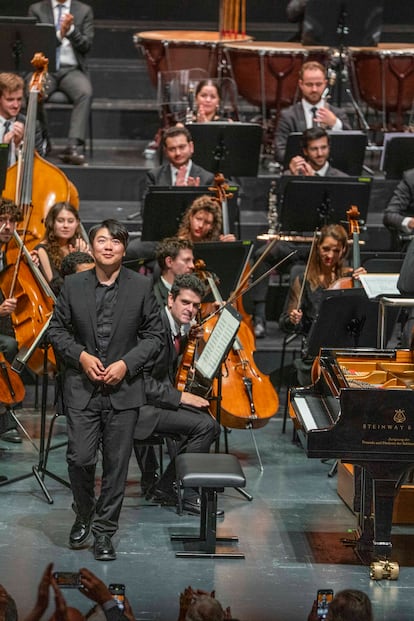
Already seated for the rest of the concert, Barenboim accompanied Lang Lang, a pianist he has always supported, in Mendelssohn's youthful and volatile Piano Concerto No. 1. The Chinese man, who knows everything, lets the conductor, whom he reveres, tell him, without any possible rebellion on his part, where to approach the piano, when to bow, when not to, when to leave the stage, and the Argentine accompanies him this time with a score (although sometimes he forgets to turn a page and at other times makes a false entrance, which provokes knowing glances from the musicians, who ignore it), a luminous version, now very similar to the one they recorded, also in Chicago, more than two decades ago. Lang's trills, scales, and arpeggios are astonishing, because he possesses an easy and precise mechanism that, alongside Barenboim, he puts strictly at the service of the music, leaving aside frills. By the time he plays the encore—a rather jaunty version of Chopin's Mazurka, Op. 33 No. 2—it's already a somewhat different Lang Lang, because Barenboim hasn't come on stage with him.
But the miracle was yet to come with the "Eroica" Symphony , a faithful traveling companion of Barenboim's, a work he has continued to explore to this day, a work that changed the course of musical history. The first movement (unfortunately omitting the exposition repetition) depicted a fiercely human heroism wrapped in all the lyricism that a frequently harsh and stark score allows. And in the "Marcia funebre, " the miracle occurred. At almost 19 minutes, it surpassed his slowest recorded performances, which already far surpassed the already leisurely versions of Furtwängler or Klemperer, his main references. This music touches him now more than ever, of course, and he knows how to capture its colossal architecture and illuminate its depths with unparalleled mastery. The emotional cataclysm, the arrival at the summit, the dazzling light, occurred in the fugue, enveloped in a strange aura of inevitability and completely transcending physical boundaries with the entrance of the horns: it's impossible to verbalize it. After catching his breath in a transparent and vital Scherzo, he presented the last movement—again very slow, lasting over 14 minutes—as another progressive ascent, culminating this time in an imposing double fugue and a coda that, at that point, still sounded incomprehensibly full of power and energy.
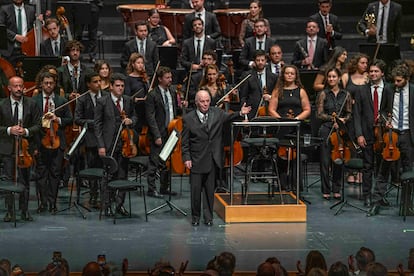
Barenboim achieves all this with barely a gesture, with a semi-absent air, but, of course, this orchestra is his creation, it is his flesh and blood, and although several generations of instrumentalists have passed through its stands in this quarter-century, the creator spiritus has always been his, which has infused them with values, essences, and manners. The music emanates from him, even with its current passivity, and, just as only Isolde can hear the melody emanating from Tristan's corpse , which she makes her own, his musicians—mostly Arabs and Israelis living peacefully together, with his son Michael as concertmaster—also hear it, even though he gives few instructions and leaves them to their apparent free will. It is his presence that changes everything, that keeps their minds magnetized. In full physical decline, the Argentine has become a Spätstil himself, a "late style," a concept so well analyzed by his friend Edward Said , co-founder of the Divan, and so identifiable in Beethoven himself, as also explored by Said's teacher, Theodor Adorno. That Barenboim can still conduct in his physical state defies rational explanation. That the results are what were heard Friday at the Grosses Festspielhaus in Salzburg is something of an unfathomable mystery. At the end of the "Eroica," and after a good hour of concentration, of course, the fourth hero of the concert seemed exhausted, wasted, dead. But he is happily alive.
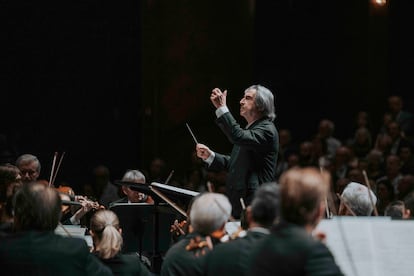
Almost a strict contemporary of Barenboim and, like him, permanently immersed in a state of wisdom, Riccardo Muti conducted a grand concert for the Vienna Philharmonic on the morning of that same Friday (a holiday in Austria). The program included works by Franz Schubert and Anton Bruckner, a natural pairing given how much the latter learned from the former. The Italian has also long since renounced all unnecessary gestures and barely leaves the podium, contrary to the constant kinetic movement cultivated by many young conductors. The curious thing is that Muti doesn't move more because he doesn't want to; Barenboim, probably, because he can't. The "Tragic" Symphony was a paragon of classical restraint and balance: although premonitory of future tragedies, it was written by a 19-year-old Schubert. Everything flowed naturally for the Italian: that certain Sturm und Drang spirit that still inhabits the first movement, the simple melody of the second, the syncopated minuet, the resolution of the tensions in the final Allegro , in which he didn't repeat the exposition, perhaps aware that it is the least accomplished movement in the work. The orchestra appreciates him, respects him, and, as he radiates auctoritas in every look, in his meager but crystal-clear gestures, what is heard almost resembles chamber music made between old friends.
Bruckner's Mass in F minor could be understood as a celebration of the feast of the Assumption of the Virgin in very Catholic Austria. It is a work not without its ingenuity: in fact, its gestation is contemporaneous with the composer's First Symphony . Here too, Muti did not go all out on the dramatic side, although F minor is a key that lends itself to it. He did carefully grade the tensions, such as the progressive crescendo of the Kyrie, although—an old fox—he did spill the beans on the best moments of the work: the great fugue on In gloria Dei Patris , the sudden outburst of Et resurrexit , the (very free) fugue on Et vitam venturi , and, above all, the Benedictus and Agnus Dei, the sections that contain—by far—the most mature and moving music of the Mass. In the first, the soloists (Ying Fang, Wiebke Lehmkuhl, Pavol Breslik and William Thomas) stood out, although they don't often get the opportunity to do so, and throughout the Mass the Vienna State Opera Choir performed in a much more in-tune way than in Maria Stuarda . One detail worth noting, or a warning for sailors: after the interval, the concertmaster, Rainer Honeck, was the only one who came on stage with his score in his hand (the rest had their music on the music stands): he had been reviewing his solos from the Kyrie and the Credo.
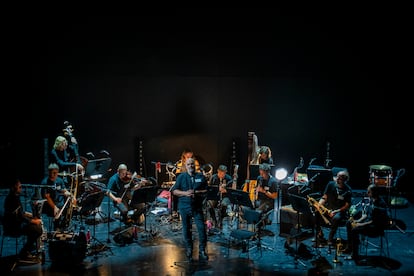
On the two nights preceding Muti's concert with Schubert's Fourth Symphony , two antagonistic versions of Die schöne Müllerin , the first of two song cycles by the Austrian composer, were heard—and will be hard to see programmed again anywhere else. These were the contemporary performances of his syphilis contracted, which would ultimately lead to his death just four years later. The first featured the great baritone Florian Boesch with Musicbanda Franui, a long-established Tyrolean group that defines itself as "a transformative station between classical music, folk music, jazz, and contemporary chamber music." From a very different perspective than that adopted by Hans Zender for his "composed interpretation" of Winterreise , Boesch and his compatriots present the Schubert cycle as if performing it from a small stage at a village festival. Boesch sings into a microphone, substantially changing the way he emits and projects his voice compared to when he does it with a piano, there are changes in lighting and, above all, the music reaches us completely recreated and metamorphosed with a handful of instruments that we would never imagine in these matters: two trumpets, trombone, hammer dulcimer, zither, harp, saxophones, clarinets, tuba, violin, double bass and accordion, the latter two played by Markus Kraler (which inevitably reminded us of our Javier Colina), responsible, together with the trumpeter Andreas Schett, for the extremely ingenious, sometimes bordering on hooliganism, musical arrangements. There are nods to the klezmer tradition ( Des Müllers Blumen , Trockne Blumen ), changes in timbre and vocal register when Boesch embodies other poetic personas (the miller's wife, her father, the brook), verses that she seems to recite more than sing (a good part of Der Jäger ), literally deconstructed accompaniments (such as the introductions to Der Neugierige , Eifersucht und Stolz , Der Jäger and Ungeduld , the latter two entrusted to the tuba), a festive atmosphere ( Mit dem grünen Lautenbande , the end of Des Müllers Blumen and Trockne Blumen ), added instrumental postludes ( Eifersucht und Stolz ), folkloric nods ( Der Müller und der Bach, a dialogued poem in which several of the instrumentalists also sing, and who do so again in the last song, Des Baches Wiegenlied ). or military ( Die böse Farbe ). Die liebe Farbe , which marked perhaps the most moving moment of the concert, was a paragon of intimacy, with dulcimer accompaniment and pizzicati from violin and double bass, with one of the two trumpets sometimes doubling Boesch in pianissimo . On the whole, the drama is played down, in line with what the Austrian baritone has always maintained: that in the end there is no suicide of the young miller's apprentice, as has always been the case. Hence the Gute Nacht in the last verse of the cycle, when the stage is filled with light and optimism, seems directed more at the audience than at the main poetic persona of the cycle. Boesch is, along with Christian Gerhaher, the greatest virtuoso of German diction among current baritones: and this too plays a crucial role in his approach. In the middle of the cycle, between the tenth and eleventh songs, Musicbanda Franui played a very free version of the Kupelwieser Waltz , a true obsession for Juan Benet , who passed this obsession on to his disciple Javier Marías. The latter would have thoroughly enjoyed hearing it transformed, thanks to an expansive arrangement that was almost a soundtrack.
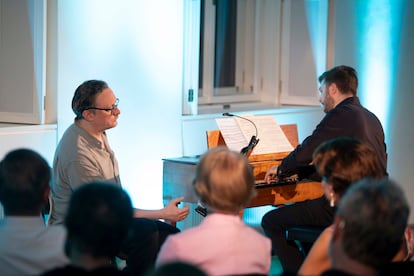
On Thursday evening, Georg Nigl concluded his series of "Little Night Musics," the first three installments of which have already been discussed in previous reviews , with Die schöne Müllerin : from the evening celebrations in a Tyrolean village, we move once again to the intimate familiar setting of a hall in the Stefan Zweig Zentrum in Edmundsburg. After having used three harpsichords and a table piano, Alexander Gergelyfi turned to a fifth historical instrument: another table piano built by Carl Withum in the first decade of the 19th century, with a range approaching five octaves and equipped with two knee pads to activate the moderator and mute. Nigl once again sang seated, with a score and a towel ready on the back of his chair to wipe his sweat: formalities, at the very least.
Nothing was like the night before, of course, but rather we experienced a corollary of the three previous proposals, albeit this one concentrated in a single work. From Das Wandern , the song that opens the cycle, Nigl showed his four main cards: an absolutely spontaneous interpretation, nothing premeditated, to the point that someone unfamiliar with him might have thought they were coming into contact with music for the first time, such was the sense of discovery and surprise he managed to convey; the introduction of small ornaments in the strophic songs or in the repeated passages; an almost constant predominance of the half-voice, which notably accentuated the risks in the numerous passages sung in falsetto and, on the other hand, reinforced the drama of the moments when he resorted to full voice, as in the last lines of the four verses of "Ungeduld," sung with a growing dynamic, or in the final verse of Trockne Blumen , proclaimed to the four winds; and the recourse to declamation where Müller's poetry best allows it, as in the fourth verse of "Der Neugierige" or in the last two lines of "Pause," over the slowly arpeggiated piano chords (before this song, incidentally, there was a brief pause to open the windows and air and cool the room). The final lullaby, a whisper from beginning to end, had nothing to do with Boesch's, but was just as emotionally effective. The four "little night songs" by Nigl and Gergelyfi have provided great and unusual listening experiences in recent days.
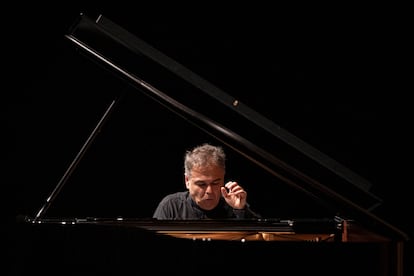
One of the pieces included in Arcadi Volodos's recital program on Wednesday evening was the penultimate song from Die schöne Müllerin , the dialogue between the young miller and the brook. The Russian played it in Franz Liszt's setting, giving, as he had just done in another transcription of Litaney 's Hungarian, a song about All Souls' Day, a master class in how an accompanied melody should be interpreted, no matter how many leaves surround the branch. Before that, he had opened his recital with the six Moments musicaux , also by Schubert, riddled with silences, very slow, without a drop of affectation, ennobling the oft-abused third, highlighting the Bach-like vein of the fourth with a miraculous left hand, and building a grandiose miniature drama in the sixth. With Volodos, nothing is trivial; everything has just the right weight and duration, translated into a sound of astonishing quality—and personality. Sitting in an ordinary chair, Volodos barely moves, doesn't make a single gratuitous gesture (not even when he waves and modestly acknowledges applause), absorbed as he is in his performance. Nothing like, for example, marketing products like Víkingur Ólafsson's, where everything seems like fake poses to hide shortcomings: time will decide for both, if it hasn't already.
The Sonata D. 959 was a monolithic block in which the form of each movement gradually took shape beneath his fingers. The highly modern coda of the first movement was surprising, full of pauses and angles, almost like a distant Webernian presage. In the Andantino , the chords were dry and incisive, and the pianissimo passages seemed to arrive from offstage. The Scherzo Trio was also extraordinarily bold, uncovering traditionally unnoticed treasures. The silences were transcendental at the end of the rondo, which the Russian pianist brought to a spectral close. Volodos is reminiscent in many ways, though not in others, of Grigory Sokolov, who like him was born in Leningrad, although they both live in Spain. Both tend toward introspection, and their concertos also have something of an auto sacramental. Volodos, who only plays recitals, is one of those very few transcendent musicians, as is Sokolov himself , or as Gustav Leonhardt was in his day. He played four pieces off-program (another point in common with his compatriot, always generous in his farewells), and not just any or predictable ones: the Ländler D. 366 No. 3 (very slow and metaphysical), as an epilogue to his monograph Schubert; Liszt's Hungarian Rhapsody No. 13 (without a single hint of hollow or banal virtuosity); Brahms's Intermezzo Op. 117 No. 1 (no one currently plays the Hamburg native's latest piano collections like him); and Pájaro triste (Sad Bird), the fifth of Mompou's Intimate Impressions (a composer to whom he has been faithful for years). The success was resounding.
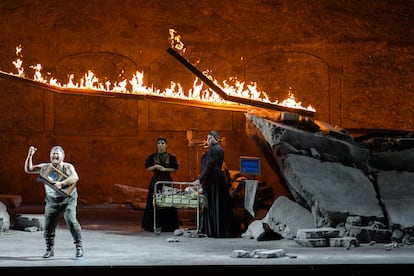
But if there's one thing that has happened in Salzburg over the past two weeks that, by virtue of its audacity, its novelty, and its capacity to stir consciences, will be remembered above all else, it will be the new production of the opera Tri sestri (Three Sisters), by the Hungarian composer Péter Eötvös, who died last year . It cannot be said that it is one of those contemporary operas with a short run (or one that barely survives its premiere, as there are so many), since since its premiere in Lyon in 1998, it has been performed in theaters in Budapest, Hamburg, Paris, Brussels, Bern, Munich, Vienna, Zurich, Buenos Aires, Frankfurt, and Yekaterinburg, and the list is not exhaustive. Of course, the majority will know Eötvös much better as a conductor than as a composer, since for a good part of the second half of his life he devoted himself to the former activity to the detriment of the latter, something similar, for example, to what Pierre Boulez did, who became a kind of mentor to the Hungarian by choosing him to be the first musical director of the Ensemble intercontemporain, a decision that is more than revealing of his talent (and of the Frenchman's extremely fine sense of smell, beyond his legendary hearing).
Almost nothing in Tri sestri is conventional. Eötvös assigns the essential part of accompanying the voices to a group of just 18 instrumentalists, who are located in the pit, and in which the only unusual presence is an accordion, while an orchestra of fifty musicians must play from the back of the stage (which requires a second conductor, of course). In a decision of great dramatic effectiveness, Eötvös associates each of the characters with a specific instrument: oboe (Irina), flute (Olga), clarinets (Masha and Kuligin), bassoon (Andrei), soprano saxophone (Natasha), horn (Tuzenbach), trumpet (Vershinin), trombone (Doctor), percussion (Solioni), double bass (Anfisa), and a string trio when the three sisters sing. For those unfamiliar with Chekhov's play, these pairings also help to quickly create a mental map of who's who.
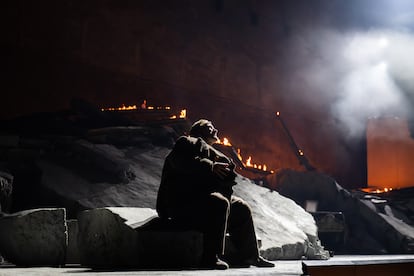
But the most original feature of Three Sisters is perhaps that it abandons the temporal linearity of Chekhov 's plot. The libretto is constructed, instead, with a prologue (taken, paradoxically, from the end of the original play) and what its author calls three sequences, focusing, respectively, on Irina, Andrei (the brother), and Masha. The eldest sister, Olga, lacks her own sequence because she is the main observer, reserving the final corollary for herself at the end. And in each of these sequences, fragments of text are haphazardly grouped together that are especially relevant in summarizing the life tragedy of these three characters. Thus, for example, Irina's sequence begins with a scene from the third act and continues with several others from the second, the first, the second again, and the fourth. This also explains why characters who had died in the first sequence (Baron Tuzenbach) reappear alive later, why the fire from the original third act appears in the first sequence, or why we see the same action repeated: when the Doctor, drunk, smashes the same wall clock against the floor in both the first and second sequences. With these leaps back and forth, which are also related to the multiple perspective of the same events adopted by Akira Kurosawa in Rashomon, Eötvös and his librettist, Claus H. Henneberg (the same one who wrote Aribert Reimann's opera Lear , which was seen at the Teatro Real last year ), shatter all expectations and leave us at the mercy of a suspended, stagnant, twisted time, which is also a metaphor for the fact that where the action takes place (a provincial city) the passivity of the different characters prevails, a non-time, while it is in Moscow (the El Dorado that the three sisters dream of and imagine themselves happy in) where activity reigns and time really advances as things happen. Fate, by the way, wanted Aribert Reimann and Péter Eötvös to die last year just eleven days apart.
Tri sestri is a child of its time in another surprising substantial element, namely the assignment of the three main female characters to three cross-dressing countertenors, with registers equivalent to those of a soprano (Irina), a mezzo (Masha) and a contralto (Olga). Natasha, her terrible sister-in-law, is also entrusted to a very high-pitched countertenor, somewhat in line with those comic characters from 17th-century Venetian operas (such as the Satirino in Cavalli's La Calisto , which could be seen this summer at the Aix-en-Provence Festival ). By originally publishing Three Sisters at a time of the emergence of Baroque operas, especially those by Handel, Eötvös made an archaically avant-garde decision that pointed to the future, increasingly common presence of countertenors in the theaters. Without going any further, they have sung in most of the stage works that have been seen this year in Salzburg: Hotel Metamorphosis , Mitridate , Giulio Cesare in Egitto and, of course, Tri sestri .
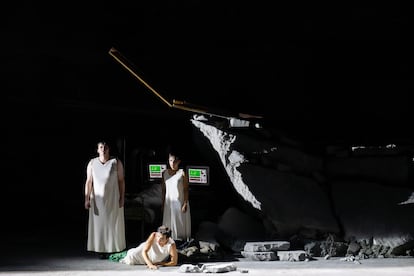
Rufus Didwiszus's striking set, ideal for the Felsenreitschule's grand setting, presents us with a ruined, dilapidated, apocalyptic world, with broken railway tracks and, in the center, a bed where the four siblings' ailing mother spends the entire day. Completely eliminated from the typical Chekhovian interiors, the entire opera takes place in this inhospitable, unwelcoming, gloomy space, where the characters—dressed in total dissonance with their surroundings, especially Natasha, played by Korean sopranist Kangmin Justin Kim—struggle to survive: above all emotionally, of course. The stage direction of Yevgeny Titov, the protagonist of a meteoric career in both spoken word and opera, is a marvel of adaptation to the music: everything he does has a reason and, more importantly, a consequence, which permeates, drop by drop, the conscience of the spectator, who ultimately empathizes with the collapse of all the characters. The climax occurs in Andrei's monologue at the end of the second sequence. At the beginning, Titov presents the brother as almost obese compared to the first, a visual indication of his progressive degradation. And Jacques Imbrailo, the protagonist of the unforgettable Billy Budd directed by Deborah Warner at the Teatro Real , gradually sheds all his clothes while also baring his soul and making us share his misery: "Now the present has become repulsive to me, boring and gray, meaningless and devoid of joy." With the bassoon accompanying him at the beginning with a pounding F-sharp, which reflects his vital monotony and boredom, his lament, of quasi-baroque character, deals us a second blow - even more painful - after having seen how Irina's dreams were shattered with the death of the baron.
In the third sequence, the mutual declaration of love between Masha and Vershinin, who has known the three sisters since they were children, is also of no use after his wife has tried to take her own life again: there is not a single glimmer of hope left, even if Titov decides to slightly sweeten the final bars of the work (very high notes from the violin over the sustained chords of the accordion, which is the instrument we had heard solo at the very beginning, as had happened in Die schöne Müllerin by Boesch and Musicbanda Franui) with an addition of his own: the mother gets out of bed to taste with her finger the cake with which Irina's name day was to be celebrated. Dennis Orellana (Irina), Cameron Shahbazi (Masha), and Aryeh Nussbaum Cohen (Olga) are physically and vocally perfect for their three characters, especially the Honduran, with his very white voice and childlike appearance, which suits the youngest of the sisters perfectly. The entire cast performs outstandingly (no doubt also thanks to Titov), and in the pit, at the helm of the Klangforum Wien, Maxime Pascal once again demonstrates that he is currently the first choice for such demanding contemporary repertoires. He triumphed in Jakob Lenz 's unforgettable concert version of Wolfgang Rihm at the Mozarteum in 2022 and, also in Salzburg, he received praise for Martinů's La passion greca in 2023, as well as – that same summer – for Kurt Weill's La opera de quatre fois in Aix-en-Provence . Now he is responsible for bringing the extremely complex musical section of Tri sestri to life with the utmost perfection and naturalness: Esa-Pekka Salonen, present in the hall, couldn't take his eyes off his arms, capable of giving a thousand and one cueings—including those of the singers—and marking a thousand and one different bars with no apparent effort and complete ease. Despite the emotional beating they had been subjected to, the audience left the Felsenreitschule with satisfied faces and, quite possibly, with a desire to reflect on their own lives, open floodgates, unearth secrets, and uncover lies: happiness must be earned.
EL PAÍS




%3Aformat(jpg)%3Aquality(99)%3Awatermark(f.elconfidencial.com%2Ffile%2Fbae%2Feea%2Ffde%2Fbaeeeafde1b3229287b0c008f7602058.png%2C0%2C275%2C1)%2Ff.elconfidencial.com%2Foriginal%2F26e%2F7bd%2Fd37%2F26e7bdd37269e6439b3d1760e8ca5901.jpg&w=3840&q=100)